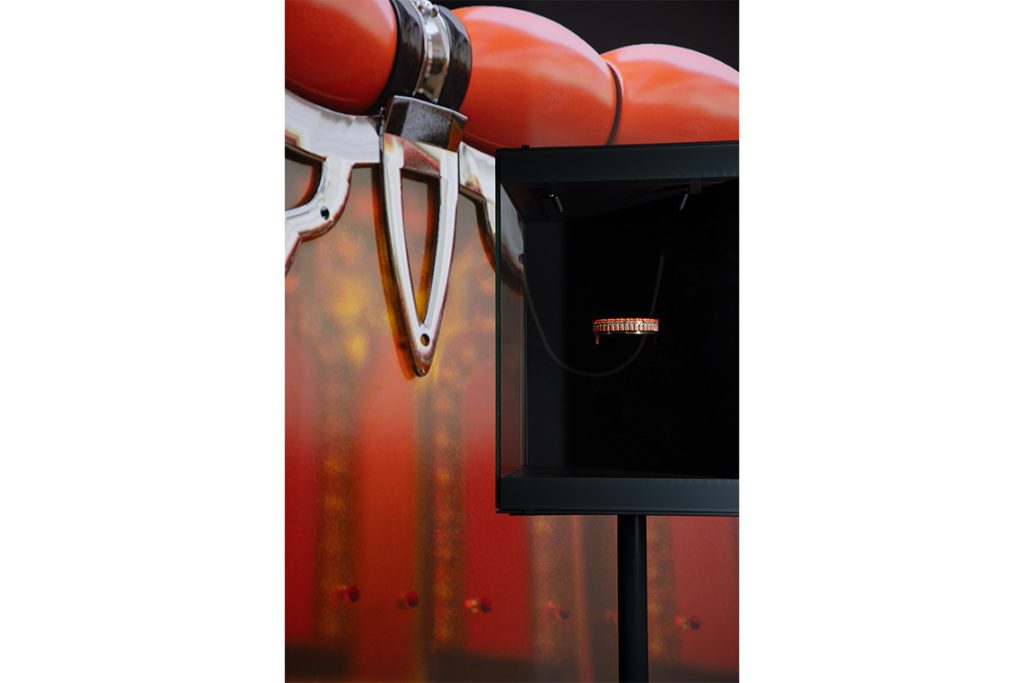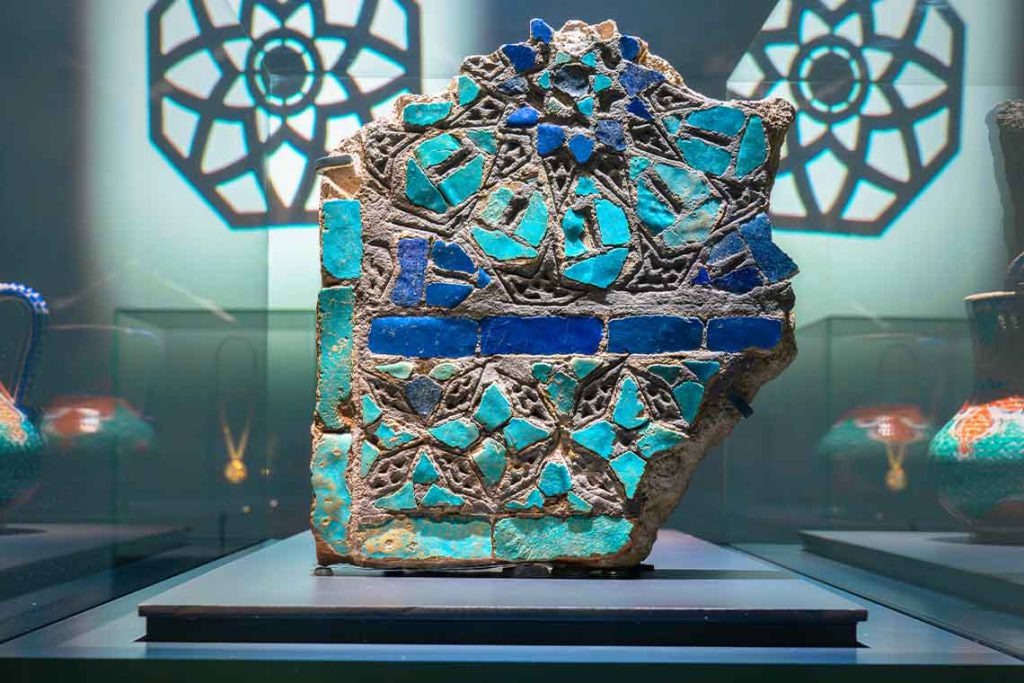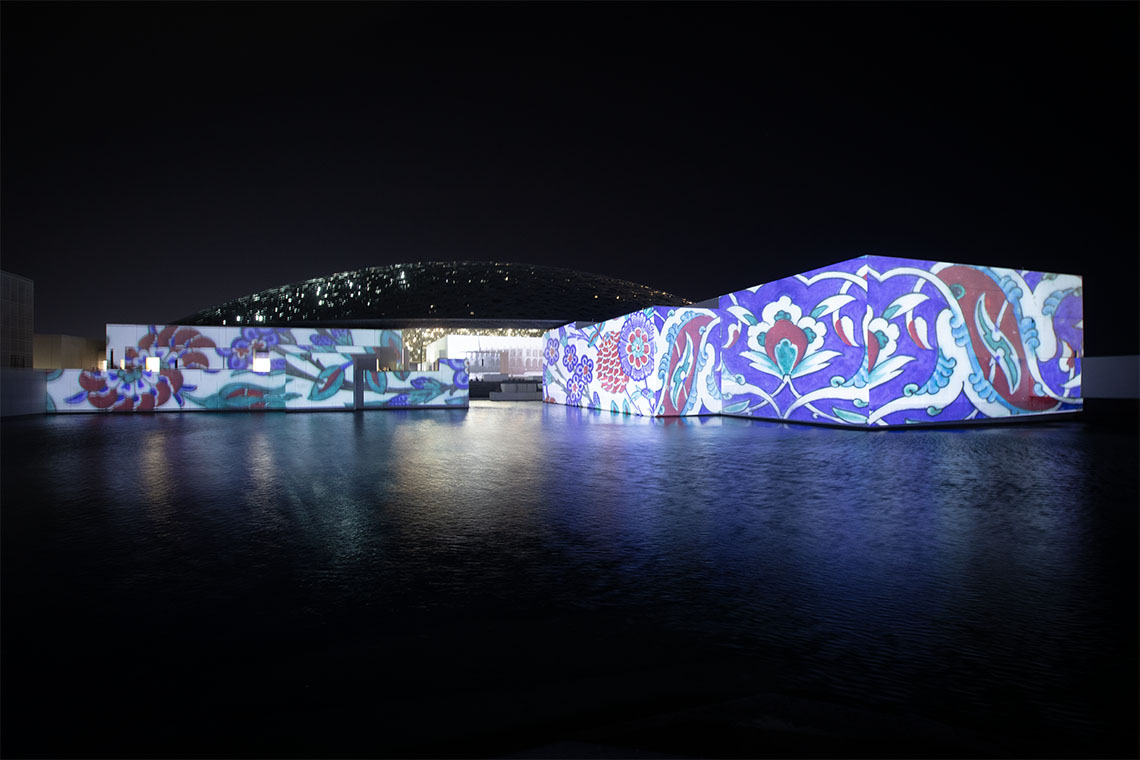Taking a forensic look at luxury jeweller Cartier’s early 20th-century modernist designs, Cartier, Islamic Inspiration and Modern Design at Louvre Abu Dhabi intertwines the Maison’s iconic designs with the depth and breadth of art from across the Islamic world.
The decorative arts of 19th-century Paris embraced eclecticism, a medley of styles from the past that saw the blending of Roccoco and Neoclassical elements in the design of a single vase, for example. However, as the 1900s dawned, a new generation of artists, designers – and, crucially, consumers – were looking for something “appropriate for a new century”, as Pierre Rainero, Director of Image, Style and Heritage at Cartier, explains. In an era of rapid technological advancement that saw the proliferation of new electric light, radio and automobiles, designers in Paris and beyond demonstrated “a generational consensus that the forms of artistry around them were not in line with what was going on in society and art,” he continued. They were looking for something completely different, and many found inspiration in the art and decorative objects from the Islamic world.
It is not known exactly when Louis Cartier, the grandson of the Maison’s founder, Louis-François Cartier, began collecting the manuscripts and objects from the Islamic world that would eventually serve as a source of inspiration for the Maison’s designers. Rainero notes the possibility of a family interest emerging with the founder’s study of Eastern languages in the mid-19th century. As a fascination with Islamic design from Persia exploded in early 20th-century Paris, Louis was likely drawn to the art motifs and colours that he saw in books about the Islamic world. He also would have seen the objects from the Middle East and North Africa that were increasingly collected and displayed by Parisian museums, including the Musée des Arts Decoratifs, with whom Louvre Abu Dhabi, alongside Paris’s Musée du Louvre and France Museums, has organised this exhibition with Cartier’s support.
The connections that the two curators of Cartier, Islamic Inspiration and Modern Design draw between these influences and the jewellery made under the creative direction of Louis are clear. Judith Hénon-Raynaud, Chief Curator and Deputy Director of the Department of Islamic Art at the Musée du Louvre, and Évelyne Possémé, former Chief Curator of Ancient and Modern Jewellery at the Musée des Arts Décoratifs, discovered direct links from Islamic art motifs to a brooch or necklace, for instance, that Cartier produced at that time. The exhibition greets visitors with installations showing books kept in the Maison’s library and opened to display illustrations of Islamic design motifs and architectural elements, alongside drawings by Charles Jacqueau, a designer who joined Cartier in 1909 and remained with the Maison for the rest of his life. Jacqueau’s drawings draw unmistakable inspiration from Islamic designs in the books, evident in the geometry of the diamond watch and exquisite tiara that accompany them in the display. Tracing this path allows visitors to follow the creation of historic pieces of jewellery from concept through to manufacture.

Through minimalist exhibition design and clever curation, the exhibition elegantly communicates the routes by which the Maison came into contact with forms, motifs and colours from across the Islamic world, selecting and adapting them to create its own masterpieces. More broadly, Cartier, Islamic Inspiration and Modern Design is a unique opportunity to understand the art history, creative process and craftsmanship of iconic jewellery designs, in addition to witnessing the remarkable pieces themselves. “This approach makes the design process accessible to all our audiences,” says Fakhera Alkindi, Senior Curatorial Assistant at Louvre Abu Dhabi. “I think everyone can understand what beauty is,” says Louvre Abu Dhabi Director Manuel Rabaté, “and what we appreciate in Cartier’s approach is that there is this genuine desire to share and give access to beauty.”
In the 39 exhibitions dedicated to Cartier and presented by museums around the world since 1989, the jewellery maker’s creative process has never been documented in this way or in as much detail, explains Rainero. The exhibition is the result of nearly five years of research into the archives, drawings and photographs of Maison Cartier, reveal curators Evelyne Possémé and Judith Henon Raynaud, “as we attempted to uncover the links between Cartier’s creations and Islamic arts, identifying the sources of their inspiration.”
Cartier, Islamic Inspiration and Modern Design sits firmly at the heart of the Louvre Abu Dhabi’s mission. “The museum brings together diverse cultures to illuminate these universal tales of humanity, transcending civilisations, time and geographies,” says Dr Guilhem André, the museum’s Acting Scientific, Curatorial and Collection Management Director. “As a universal museum firmly rooted in the UAE, our mission centres on what unites us: the stories of human creativity.”
Telling the story of Islamic art in any context can be a challenge, as Possémé and Henon Raynaud admit. “What we call ‘Islamic art’ cannot be described as a unique and unified production, not only because of the wide geographical range – from Spain to India – but also because of the large time frame covered, from the seventh century to the 19th century.” By bringing in works of Islamic art from the many design centres across the Arab world, spanning North Africa, Turkey, the Levant, Iran and India, as well as from different periods throughout Islamic history, “Cartier, Islamic Inspiration and Modern Design reflects this diversity,” says Alkindi.
In the exhibition’s centrepiece, a display case running the length of the gallery tells the broad story of Islamic art, as well as its influence on Cartier’s designs. Twentieth-century necklaces, brooches and cigarette cases are shown next to a centuries-old Egyptian door panel, a c.16th-century candlestick from Iran and a pen box from 17th-century India. Together, they show the use of abstract and geometric patterns in the variety of architecture and decorative arts for which Islamic art is renowned.

The evolution of these influences on Cartier’s creative direction was continued by Louis’s brother Jacques, who ruled the Maison’s London branch in 1906. Travelling extensively in the Arab world and India, Jacques acquired a variety of art objects and other material as he strengthened business ties with leading figures, including maharajahs. The regional techniques he witnessed, as well as the raw or worked materials such as emeralds and even photo albums that he brought back to Cartier, all “played an instrumental role in this dynamic exchange,” Alkindi says.
When Jeanne Toussaint took over the creative direction of Cartier from Louis in 1933, she opened the Maison to the innovative use of these materials, incorporating carved gemstones from India into existing jewellery pieces, deconstructing elaborate pieces acquired in India and making new pieces from them, and incorporating inspiration from Maghreb designs and Ottoman ceramics. Toussaint also added amethyst to the bold hues of blue and green in Cartier pieces that reinvigorated the Parisian design landscape.
The design of the exhibition itself, elegant and understated yet strikingly inventive, is reflective of this juxtaposition of ancient works and modern design. A spotlight is positioned below an elaborate pendant to amplify the artistry of its intricate design in an oversized shadow cast on the wall behind.
“We were fascinated by the mathematical magnificence of these engineered artefacts, the intricacy of their connections, the clear influence of Islamic architecture and – of course – the level of abstraction, which is so resonant for 20th-century art and 21st- century viewers,” enthuses Elizabeth Diller, co-founder of Diller Scofidio + Renfro, the design studio behind the immersive digital space and exhibition scenography. Both in the gallery and in a satellite space, analytical videos project large-scale animations of Cartier pieces in minute detail, showing the placement of each gem, hinge and clasp. Like the exhibition, these minimalist visual stories zoom in on a motif in Islamic art and translate it to the design of a necklace or an armband, tracing the two histories of Islamic art and modern design. In this way, both trajectories have, as Rabaté affirms, “something to teach us about creation and the beauty of mankind’s capacity to create.”
Cartier, Islamic Inspiration and Modern Design runs until 24 March 2024
This review first appeared in Canvas 111: Crafting the Contemporary



